
Vertebrates (pdf)
Whatever happened to the humphead wrasse, Cheilinus undulatus, after its CITES Appendix II listing?(pdf)
The Napoleon fish, or humphead wrasse (So Mei in Cantonese) (Fig. 1), was one of the first commercial fish species to be listed on a CITES (Convention on Trade in Endangered Species of Flora and Fauna) Appendix when delegates from more than 150 countries reached a consensus that it be included on Appendix II in October of 2004. Species are listed on Appendix II if they can be demonstrated to be currently or potentially at risk of extinction if current practices persist. Because of the heavy and largely unregulated international trade in live individuals of this species, for food, mainly into and through Hong Kong, this species was considered to be at risk. The CITES listing is a powerful and positive step in the direction of sustainable management because the Convention requires that exporting countries demonstrate that exports are sustainable. If they cannot demonstrate this, then the Convention enables sanctions on exports to be introduced, so there is strong incentive to comply. Both exporting and importing countries play a role in ensuring (through a permitting system) that trade is conducted sustainably, such that Hong Kong, on the receiving end, has a responsibility to closely monitor imports of this species.
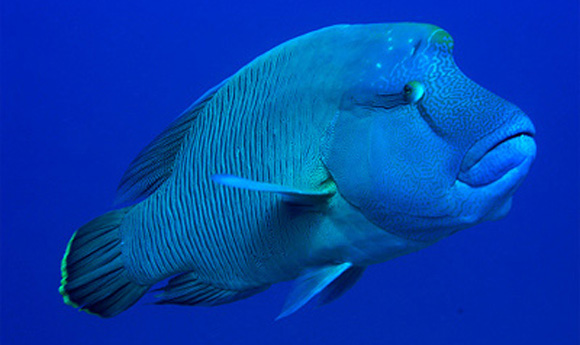 |
| Fig. 1. Napoleon fish in the wild. This spectacular creature is one of the largest of all reef fishes and can reach 2 m in length. Its populations are threatened by the live reef food fish trade which mainly passes into and through Hong Kong. (Photo: P. L. Colin.) |
The sustainable management of a large, uncommon, reef fish, like the humphead, is a challenge, given how little we know of the species, how poor the fishery and export data are in most countries, and how difficult the species is to study. One of the biggest problems with its fishery is the major focus on juveniles and small adults in trade (Fig. 2). These life history stages are ideal for restaurant demand.
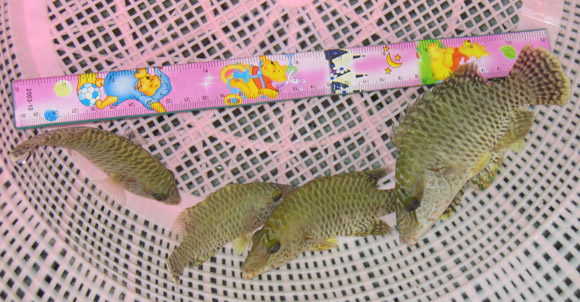 |
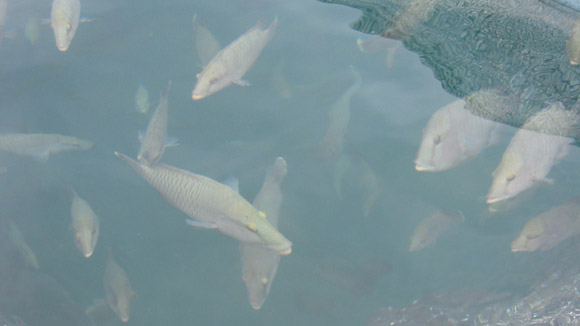 |
Fig. 2. Most fish on retail sale are at or below the size of sexual maturation (35 – 50 cm TL) which means that the fishery on the humphead wrasse is largely one of juveniles. Photos show fish being grown out after wild capture. All are below 35 cm. This is one of the major problems with this fishery because it removes late stage juveniles and small adults from the wild before they have had a chance to reproduce and replenish fished populations. [From: Development of fisheries management tools for trade in humphead wrasse, Cheilinus undulatus, in compliance with Article IV of CITES. Final Report of CITES Project No. A-254 undertaken by the International Union for the Conservation of Nature and Natural Resources - World Conservation Union/Species Survival Commission (IUCN/SSC) Groupers & Wrasses Specialist Group.]
A major exporter of humpheads is Indonesia which supplies most of the fish we see in local markets. Following the 2004 Appendix listing, the Indonesian government agreed with CITES to work with the IUCN (World Conservation Union) Groupers & Wrasses Specialist Group (which I chair out of DEB) to develop a sustainable management plan for the species. CITES initially funded this work, with the United States government providing more recent support, and I have now spent a couple of years working with the Indonesian government, and others, towards developing a stock assessment for the wrasse that can be used by Indonesia when they introduce their export quota for 2007. Ultimately, the aim is to make the stock assessment format generic enough that any interested country can use it, plug in their own parameters (such as local fish densities and areas of high and low fishing pressure) and tailor a quota to their specific and national needs. Other activities have involved lots of consultations and workshops to make countries aware of the management challenges and provide options for compliance.
There is much to report on, but I will confine myself to just two of the major activities, underwater visual census (UVC) surveys in Indonesia and an international workshop in Hong Kong. Working with Dr. Pat Colin of the Coral Reef Research Foundation we have almost completed comprehensive UVC surveys in 6 areas of Indonesia (Bali and environs, Derawan area, Banda Is., Komodo and environs, NW Sulawesi and NW Papua). The purpose of the surveys were to (a) develop an underwater sampling protocol suitable for a large, wide-ranging and uncommon species (the standard 50 m transects are not the most practical approach for several reasons) and that is easy to do, and (b) collect information on natural fish densities in areas of high, low and medium fishing pressure. These data are for the stock assessment model and represent a baseline for future work.
For the workshop, we were interested in providing background information on the species and in working towards a regionally acceptable approach to its management. Most countries have never had to work on endangered commercial fish species before and several do not even have the correct institutional framework for so doing. The international workshop (Fig. 3) was a first step in providing the necessary information and discussing management options and was extremely well received by participating country (Indonesia, Malaysia, Philippines, Papua New Guinea, Mainland China and Hong Kong) CITES authorities and fisheries personnel.
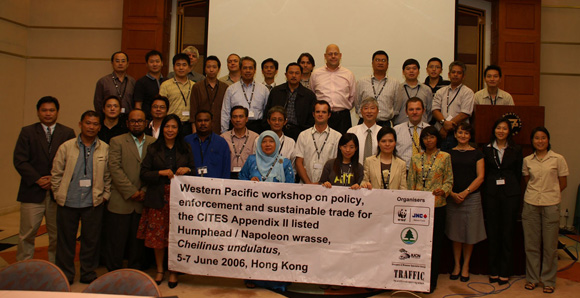 |
| Fig. 3. Workshop participants from all over SE Asia and a few beyond, including from FAO and the CITES Secretariat. (click here for larger photo) |
Mapping (Fig. 4) using a global positioning system (GPS) allows easy return to sites for follow-up monitoring and is a challenge to do successfully for such a large species and using a simple practical and readily repeatable technique. The length of the GPS track, together with an estimated swathe width, enables area surveyed and fish densities to be estimated. In the different areas visited to date (Banda and Derawan remain to be completed) fish densities ranged from lows of < 0.01 to about 1 per 10,000 m2. In very low-density areas, we had to cover at least 20 km to ensure a representative sample; for higher densities at least 6 km.
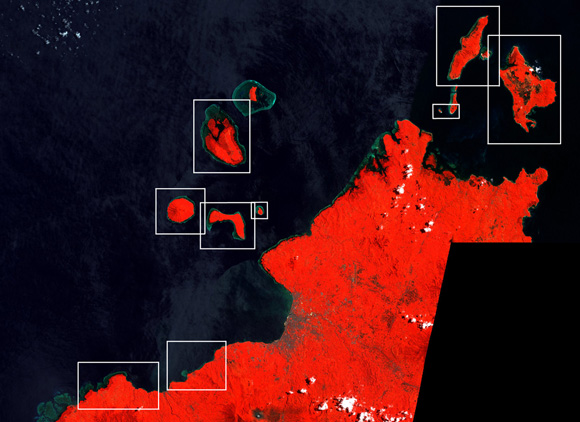 |
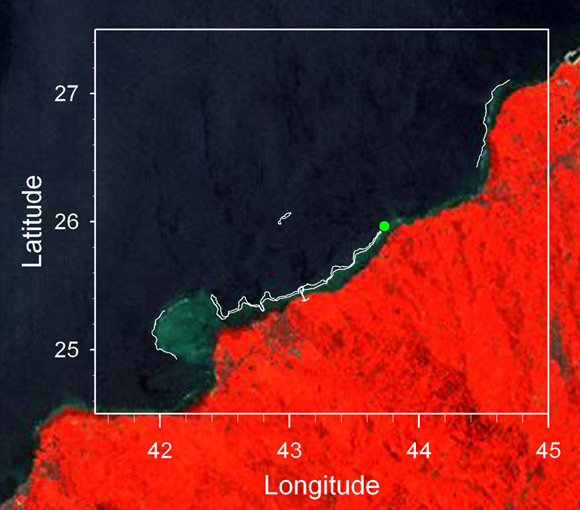 |
| Fig. 4. The two photos show satellite shots of NW Sulawesi with the sample sites shown in boxes (upper). The lower photo is a detail of one of the more southern sites, showing the GPS track swum (mainly by snorkel) as a white wavy line. The dot indicates the one fish seen at this location. |
Highlights of this work have been the challenge of developing a stock assessment model, the new UVC technique and the workshops. We have held both internal ones in Hong Kong and Indonesia as well as an international one for the SE Asian region. It has also been a pleasure to work with TRAFFIC Southeast Asia on a trade component and with FAO (Food and Agriculture Organization of the United Nations) on the fishery modelling work (stock assessment). Colleagues in Indonesia have given the work tremendous support and this diverse project has also enabled me to work with WWF here in Hong Kong, and with William Cheung, ex of DEB and now at the University of British Columbia.
Currently, only Indonesia is trying to comply with the CITES listing, with an interim export quota for 2006 of 8,000 animals 10 times less than before the CITES listing. Several countries, like Fiji and Palau, have banned exports altogether and the Philippines also does not allow exports (although fish continue to enter HK from the Philippines). Malaysia is discussing measures and, although Hong Kong has still not complied on the monitoring side, they have assured everybody that this will happen by the end of 2006 and that additional, even stricter legislation is in the final stages of approval. The hope is that within a few years, we may begin to see some progress and that follow-up surveys at our baseline monitoring sites will allow for effective evaluation of measures being discussed or put in place now. K compH
For more information on the humphead wrasse and access to reports on the above work see: www.humpheadwrasse.info.
P.10-12
|
Porcupine! |
 Copyright © 2000 |
